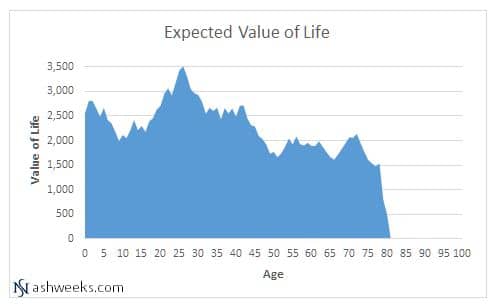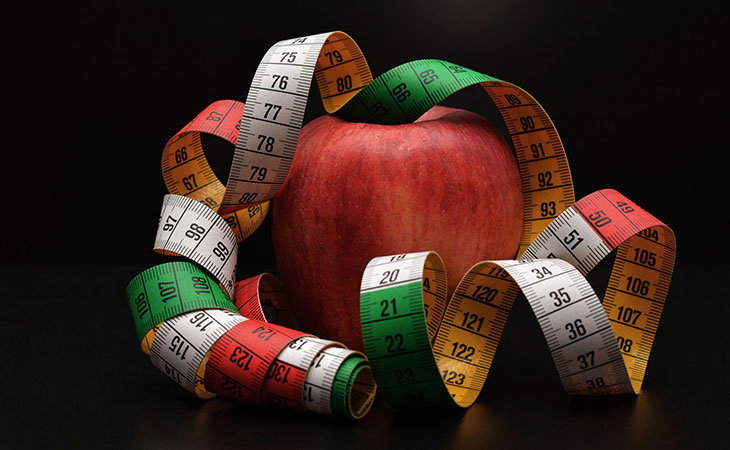How do you value life?
I attempted to do this in a Thinking Week at the beginning of 2015. It was during my search for purpose and happiness where I needed to get away from the routine that was my life, away from university, work, family, and friends, where I could be by myself, distraction free, and just think.
Taking a logical approach, I attempted to figure out the factors that contributed to my personal happiness and fulfilment and those that sapped it. The sum of the values associated with each factor would represent the value I placed on life. In the short term I wanted to increase this value and figure out what was missing in my life; why I was feeling down. In the long term the goal was to maximise it.
At the basic level, I assumed value(good factors) + value(bad factors) = value(life) at any given moment. If we represent this visually then it might look something like this:

The higher the bar, the better I felt about my life at that point in time. However, I didn’t want to focus on the value at any moment, I wanted to plan for how I could maximise the value of my entire existence. I wanted to always feel happy and fulfilled and avoid having drops in the future, like the one I was experiencing at the time.
To represent this, we will need a second axis: time. We could focus on any period that we wanted, such as a day, week, or year. For the purpose of this post, let’s graph an entire expected life. If we rated each day out of 10, we would have a maximum rating of about 3,650 for each year. The forecast might look like this1:

The graph drops off at the end because the expected life at birth of an Australian male in 2014 is 80.3 (84.4 for females)2. The subjective expected value of life would be the sum of every day’s Value: the blue area under the graph.
I propose that the goal of every individual should be to increase this area. This can be done in two ways: (1) increase the average Value of each day; and, (2) increase the length of your life. This is represented in the graph below:

Maximising the Value of Life
1. Increase the Average Value of Each Day
What gives value to someone will differ from person to person. However, value itself can be split into positive and negative groups of factors. The sum of all these factors will always be positive because life is worth living. Life is amazing. If a situation is allowed to deteriorate to such as point that an individual feels that life is actually not worth living, then we have a problem.
Positive
I have broken up each group into three types of factors based on their permanence (how long the effect of the factor sticks around): fulfilment, happiness, and pleasure. Factors that provide you with fulfilment have lasting effects on the utility you get from life, and they are also often slow to change. They are the things that provide meaning and purpose to your life, the things that make you feel you are doing something worthwhile.
For example, living by your values, loving and being loved, teaching, learning, solving problems, and making a positive difference in the world.
The second level of permanence within the positive group is happiness. The factors in this group are not as long lasting as fulfilment but they are more quickly changed. They are the things that make you smile, make you look back on your day and think it was a good one, and they tend to be the things you are looking forward to in the coming week.
For example, hanging out with friends, going to parties, listening to upbeat music, and watching your favourite TV series.
Lastly, pleasure is the name I have given the factors that have a immediate to short term effect on the feeling we have towards life. They are the shorts spikes in happiness or pleasure that fall away after hours or less.
For example, consuming sugary or fatty foods, sex, relief (from pain, stress, etc), winning something, and the feeling of rejuvenation after quality sleep.
I encourage you to list all of the factors that fit into each of the above types. Once you have finished, you are left with a tool to be used to measure how much value you are getting out of life and what areas you can focus on improving to increase that value. It includes long term things to focus on improving (fulfilment), medium term goals of making sure an appropriate amount of those activities are included in your lifestyle (happiness), and immediate to short term actions you can take to bring yourself out of a rut if you start to feel unhappy or stressed out (pleasure).
However, the key is to place more emphasis on the higher level goals and actions because these are the things that are likely to provide you with longer lasting enjoyment of life. Too much experience of the lower level factors can start to have a negative impact on your life, such as binge eating sugary or fatty foods, binge watching your favourite TV series, or over-listening to the same songs.
Negative
Similarly to the Positive group, this group can broken down into discontentment, sadness, and pain, which are essentially the opposites of the types of factors above. Discontentment is the feeling of not being satisfied with certain aspects of your life, or something being significantly wrong with something in your life. For example, feeling helpless, restrictions on your actions, disaster (financial, social, physical), and disease or illness.
Sadness includes anything that draws from your happiness, such as stress or loneliness.
Lastly, the ‘pain’ type of factors include those that have immediate to short term effects on your feeling towards life. This could include threats to you immediate safety, physical pain, or failure.
Listing all of the factors that fit into the above types provides you with a picture of things to experience less in your life. The list highlights the factors that are causing you to feel worse about the enjoyment you get from life and can help you spot certain problems areas. I have found that worrying about something vague can make you feel helpless to do anything about it, but narrowing down the cause to something specific can make the task seem less daunting and more easily conquerable.
2. Increase the Length of Your Life
This method of increasing the expected value of your life seems to be lost on some people.
Perhaps they ignore anything to do with death out of fear, or they simply have a very short term approach to life. Regardless, there are many small and large things we can do to influence our longevity.
Let’s outline some of the actions we can take to increase our chances of a longer life and list some actions to avoid which increase the chances of our life being cut short.
Actions to take
The little, everyday things that can have a big impact over time:
- have a positive outlook on your future
- keep good hygiene habits
- consume all the recommended dietary intakes of macro- and micro-nutrients
- eat a healthy amount of calories
- maintain positive relationships
- exercise regularly
- have sex regularly
- get regular health check-ups
- get enough sleep
- wear sunscreen when walking in the sun
- wear UV protective sunglasses
- lose excess weight
Bigger actions you can take, some you might not be aware of:
- sign up for cryonics ( See Time Urban’s fantastic explanation of Why Cryonics Makes Sense)
- keep up to date with advances in medical technology. For example:
- some organisations are focussing on regenerative medicine which will aid in the fight to end ageing;
- 3D printing and stem cell technology are evolving the ability to print small organs; and
- advances in robotics are enabling robotic limbs to replace missing or damaged biological limbs.
Actions to avoid
The little, everyday things to avoid that can have a big impact over time:
- getting into financial hardship3
- regularly depriving yourself of sleep
- binge eating
- eating too much red meat4
- over-restricting your calorie intake
- sitting for extended periods of time5
- breathing in polluted air
- stressing out consistently
- thinking pessimistically
- driving in a car with a low safety rating
- eating potentially contaminated food
- provoking people to the point of hostility
- isolating yourself when you feel lonely6
Bigger actions that can have a negative impact:
- living without easy access to medical services
- smoking
- consuming drugs with serious side effects
- drinking excessive amounts of alcohol
- living in a country that is at war or is likely to be at war
- taking unnecessarily risky actions (e.g. getting in a car when the driver, whether or not it is you, is legally drunk or sleep deprived)
If I have missed an important action to take or action to avoid for greater longevity, please add a comment below and I will update this post.
I challenge you to create your personalised Positive and Negative lists of factors that affect your enjoyment of life. It will give you a greater understanding of what drives you and what brings you down, and you can use the lists to maximise the value you get out of life. You can use these lists to help design your ideal lifestyle.
I used partially random numbers to generate the values and stopped generating them when the shape looked realistic enough. ↩





